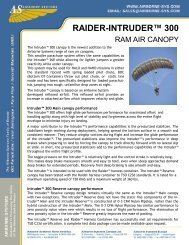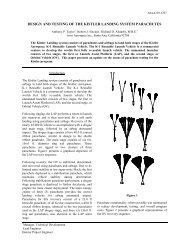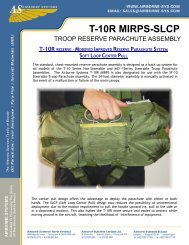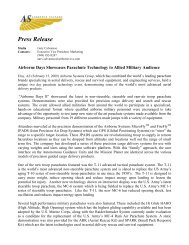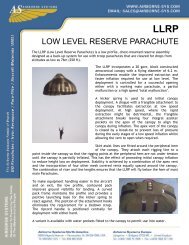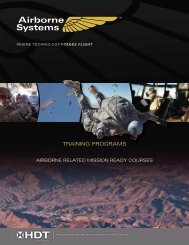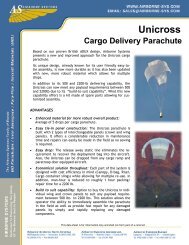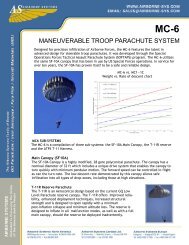"lfk f; \"A Lt. - Airborne Systems
"lfk f; \"A Lt. - Airborne Systems
"lfk f; \"A Lt. - Airborne Systems
Create successful ePaper yourself
Turn your PDF publications into a flip-book with our unique Google optimized e-Paper software.
ity which can hoist the load abovE tre ground to a<br />
release height suffcient to p'ovide a: impact a oesired<br />
vertical velocity, and usually lTeans to impart a horizontal<br />
(maximum wi1d drift or glide) velocity334 335<br />
A mooile or fixed crane of propEr height and lift<br />
capacity will setisfy vertical velocity requirements,<br />
Horjzontal velocity has been provided by more sophisticated<br />
test structures employing an inciined rail<br />
or pendulum principle.<br />
TEST FACILITIES AND EQUIPMENT<br />
Several test ranges exist within the continental<br />
United St'ltes which are fully,fnstrumented fmd have<br />
been used extf:nsively for free flight test Qperations of<br />
mi, siles, drones, aircraft and other vehicles, many of<br />
which employ recovery systems. These ranges have<br />
provided cpmplete vehicle systems testing, and in<br />
same cases. subsystem af component testing of decelerators<br />
and ather related subsvstems. They are capable<br />
of supporting flight tests with high performance<br />
aircraft or other launch means. Most ranges hav- the<br />
equipment to obtain accurate trajectory di!ta and<br />
excellent photographic coverage of a test vehicle in<br />
flght, recording such events as deployment and<br />
behavior of a trailng deceferator with real.time correlation.<br />
Some have laboratory test equipment and<br />
other support testing capabilities.<br />
Wind tunnels, normally used on a continuous basis<br />
to support aircraft and missile aerodynamic research<br />
and development, are usually available far decelerator<br />
vtfth high-<br />
testing. TlJOse with large "ass-sections or<br />
spef:d low-density air-flow, have been particularJv<br />
useful for parachute teSting.<br />
In this section, range facilities, tf!stfng equipment<br />
and graund based instrumentation (tre briefly describfJd<br />
which have been used in recovery system development.<br />
Instrumented Ranges<br />
Test range facilities an:: capabilities are identified<br />
and SUlTmarized in Table 5,3. Only una test range is<br />
devoted exclusively to recovery system research. devel.<br />
opmen:. test and evaluation. Data containec In the<br />
table a' s genera! ir nature, suitable only for preliminary<br />
planning purposes. A prospective user ShOl;!d<br />
contact the test range for specific data regarding requirements<br />
and schedules when enticipating use of<br />
facilities. Table 5. lists types of recovery system<br />
tests of test methods, and variOL;S test suppo't services<br />
available. Ground instrumentatiun emoloyed at tre<br />
variOLis ranges and other support services are described<br />
starting on page 232.<br />
213<br />
Edwards Air Force<br />
Air Force Flight Test Center.<br />
Base, California is located 100 mile:; north of Los<br />
Angeles. The test range is approximately 5 miles wide<br />
by 14 miles long. The prin:ipaluse of the range is the<br />
flight testing of aircraft. Development of parachutes<br />
and rela:ed CO'Toonents tr. rough the use of air launch<br />
and gravity drop testing techniques can be performed<br />
on this range. Human escape methods, aerial speed<br />
retardation and landing of personnel. material equipment<br />
, and all aspects of recov8ry, rescue and survival<br />
are included in the total scope.<br />
"'acilities for test prepClrali::m of parachutes and<br />
test vehicles for aircraft launch are aV8ilable, Various<br />
types of ground handl ing equipment and a'rborne test<br />
vehicles are in inver'torv. Suopon services prl!vided<br />
by the base inclL:de test vehicle preparation. checkout,<br />
parachute handling and test hardware retrieval.<br />
Chase and search airplanes and helicopters are avail-<br />
Dble. Optical and photographic data are acquired by<br />
real-time corxdinated cinetheodolites and tracking<br />
motion picture cameras. Other data are obtained<br />
with teleml:try. Photo processing and data reduction<br />
can be provided.<br />
White Sands Missile Range. The White Sands test<br />
complex is a combination of test ranges and facilities<br />
located in south cer1tral New Mexico The principal<br />
test area is the US Arcny Whi:e ds Missile Range<br />
with headquarters located 60 miles north of EI Paso,<br />
Texas. The range is approximately 48 miles wide by<br />
100 miles in length , with range area ex,:ensions<br />
(shown in FigurE 5. 19) which can be placed under<br />
ground and airspace contra!. Its principal use is for<br />
missile and gunnery development by the US Army,<br />
but Its various drop range areas arB also used by the<br />
other armed services and NASA for operatiors from<br />
their o\'vn launch and test bases. The NASA Wliite<br />
SS1ds Test Facilty Fort Bliss and Holloman Air<br />
Force Base facHities greatly enrance the overall<br />
capability :If the White Sands test complex.<br />
Radar. oPtics. weather data and telemetry are<br />
coupled to a real-tilTe data system with total range<br />
communications for data reduction purposes. or they<br />
can be used independently with the smaller area plotting<br />
facilities. Holloman Air Force Base is located<br />
40 miles nortreast of White Sands::n the eastern<br />
border of the range, and 15 miles west of Alamogarda,<br />
New Mexico. Facilities useful for recovery system<br />
and decelerator development are rocket launch<br />
areas, a high speed test track and a high altitude balloon<br />
launch facility. Excellent work areas are on<br />
hand with ground handling equipment available for<br />
most sizes of test vehicles. /\mple ground vehicles<br />
cranes, weapons carriers , trucks , airplanes and helicop<br />
ters are availaole for search and retrieval.



